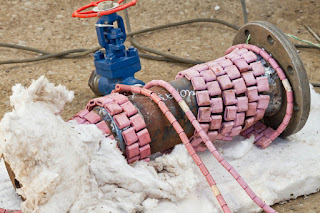Ceramic mat heaters, also known as ceramic pad heaters, play a crucial role in pre-weld heating applications. They provide controlled, uniform heating to prevent thermal stresses and ensure proper metallurgical bonding during welding. The construction and application of these heaters in pre-weld heating involve several steps.
Material Selection: Manufacturers use high-quality ceramic materials for these heaters due to their excellent thermal insulation properties. The ceramic insulates the heating wire, preventing heat loss and ensuring uniform heat distribution.
Heating Element: The core component of a ceramic mat heater is the heating element, typically made of nichrome wire. Due to its high electrical resistance, this wire generates heat when electrical current flows through it.
Ceramic Beads: The nichrome wire gets threaded through ceramic beads, essential for insulation. These beads have a hollow cylindrical shape with an opening for the wire. Manufacturers arrange these beads in a pattern, often alternating rows, to form the heater's structure.
Assembly: After threading the nichrome wire through the ceramic beads, manufacturers shape the heater into a flexible mat-like structure, which can conform to the surface it needs to heat. The ceramic beads serve as spacers between adjacent turns of the wire, preventing short circuits and ensuring uniform heat distribution.
Electrical Connections: Manufacturers attach electrical leads to the heating element, enabling connection to a power source. These leads can be customized depending on the application, such as the voltage required and the type of power source available.
Outer Insulation: An outer insulating layer, typically made of fiberglass or silicone rubber, is added to the heater mat. This layer enhances the insulation properties, provides protection against environmental factors, and prevents electrical shocks.
In pre-weld heating applications, these ceramic mat heaters ensure uniform heating and minimize thermal stresses in the welded material.
Placement: The operator places the ceramic mat heater onto the workpiece that requires pre-weld heating. The heater's flexibility allows it to adapt to curved surfaces, ensuring good contact with the workpiece.
Power Source: The operator connects the heater to a power source, usually a welding machine or a dedicated power supply unit. The power source provides the necessary electrical current to the nichrome wire in the heater, generating heat.
Temperature Control: The operator sets the desired temperature and heating rate for the pre-weld heating process using a temperature controller. The controller regulates the current flowing through the heater, ensuring uniform temperature distribution and preventing overheating.
Monitoring: The operator monitors the temperature throughout the pre-weld heating process, ensuring the workpiece reaches the desired temperature uniformly. Proper temperature control is vital to achieve optimal welding conditions and prevent issues like cold cracking or porosity in the weld.
Removal: Once the workpiece reaches the desired temperature, the operator disconnects the ceramic mat heater from the power source and removes it from the workpiece, ensuring the surface is clean and ready for welding.
By following these steps, ceramic mat heaters provide consistent, controlled heating for pre-weld applications, enhancing weld quality and reducing the risk of defects in the final product.
Hotfoil-EHS
609-588-0900












